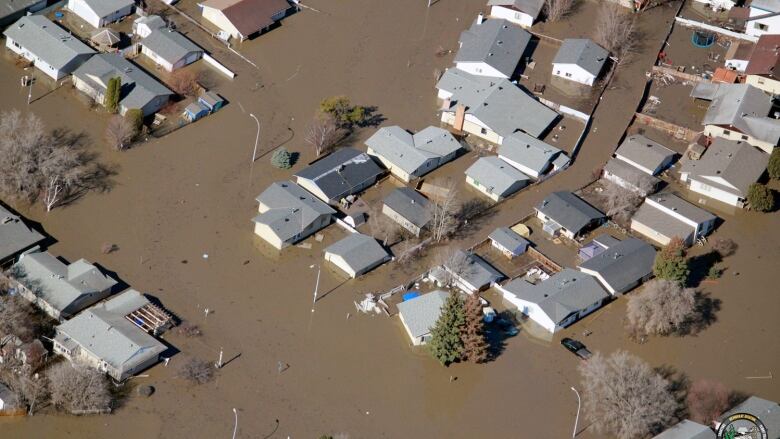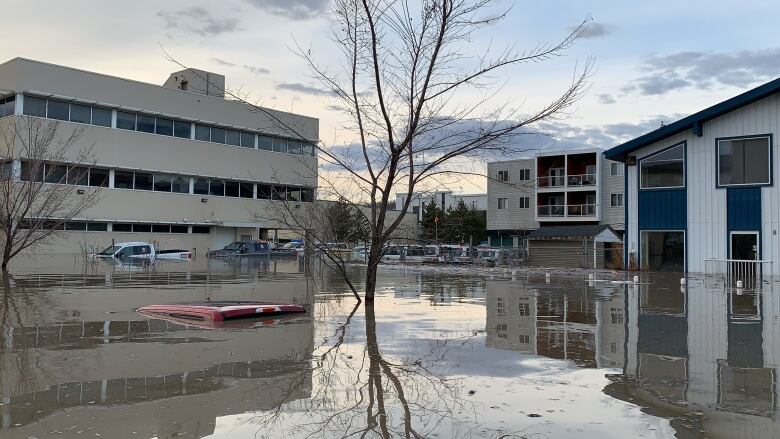Most evacuation orders lifted as Fort McMurray floodwaters recede
Mayor says warm temperatures helping to thaw massive ice jams faster than expected

As floodwaters continue to recede in Fort McMurray, Alta., mostevacuees will be allowed to return home Friday,but the municipality is warning residents to be prepared for potential property damage.
Some mandatory evacuation orders in place since flooding were lifted at2 p.m. MT, while almost all others were lifted at 8 p.m.,the Regional Municipality of Wood Buffalo said in a news release.The only remaining evacuation order is forDraper, a community 12 kilometres south of downtown Fort McMurray.
As of 8 p.m. mandatory evacuation orders will be lifted for the following areas:
- Taiga Nova.
- MacDonald Island.
- Lower Townsite.
- Ptarmigan Court.
- Waterways.
Residents and business owners can access their propertieswithout restriction but should exercise caution, the municipality said. Structures in these areas may have internal damage.
Utilitiessuch as gas, electricity and waterhave not been restoredfullyat this time, municipal officials said.A boil water advisory remains in effect across the regionand cases of water will be available to residents at the Peter Pond Mall parking lot.
Residents must not attempt to enter the area prior to 8 p.m.The municipality is also discouraging driversfrom creating lineups on Highway 63.
The return of residents to the downtown core is coming sooner than initially anticipated.
On Thursday, municipal officials estimatedit would take a week at least before nearly 13,000 evacuees would be allowed back into the flood zone.
Ice jams rapidly melting
Don Scott,mayor of the Regional Municipality of Wood Buffalo, said warm temperatures are helping to thaw massive ice jams faster than expected.
"We're very pleased with the progress we've made today," Scott said during a news conference Friday afternoon.
"I'm expecting we're going to make a lot more progress in the hours to come as well."
Scott said water level in local rivers continued to drop rapidly onFriday.
"The ice has dropped considerably," he said. "The water table has dropped. Our municipal infrastructure can now drain out. There is real progress being made."
The Clearwater River which overran its banks on Monday, flooding the downtown core dropped about a metre overnight, Scott said.
A massive ice jam that initially stretched along 25 kilometres of the Athabasca River now measures about eightkilometres and continues to melt rapidly.

The flooding began Sunday, when a 25-kilometre sheet of ice effectively dammed the Athabasca River, forcing the Clearwater to reverse course and flood the city's downtown core. An estimated 1,230 structures have been damaged.
While some areas remain swamped, images of the downtown Friday show floodwaters have receded significantly.
Some areas that were under a couple of metres of water, with abandoned cars completely submerged, now only have puddles of pooling water in the street.
Municipal officials had said a return to the flood zone will happen in stages. Essential businesses, including key government infrastructure, grocery stores, hardware stores, gas stations, hotelsand pharmacies will be given priority.
Businesses spared the worst of the flooding will be inspected and allowed to open first.
Damage assessment teams, consisting of building and safety codes inspectors, were deployed Thursday, the municipality said in a news release.
Some homes may be unsafe
Once inspections are completed, operators will be able to return to their properties to assess damagesand begin the recovery process.
Some homes, while accessible, may not be safe, cautioned Scott Davis, director of emergency services.
Utilities have not been fully restored. Sewage back-ups may have left permanent damage, and a boil water advisory remains in effect for much of the region.
WATCH | Assessing the damage from Fort McMurray's floods:
Municipal crews do not have the capacity to inspect each property damaged by the floodwaters, Davis said."Homes may not be safe to occupy and you may not be able to live in your home," he said.
"We're not able to do the assessments inside the home. We rely on the homeowner and the insurance company to make that determination."
A virtual community townhall was heldThursday to provide an update on the river breakup and flood. Environment Minister Jason Nixon said a number of provincial conditions must be met before evacuees can return.
"Those conditions include floodwater no longer being an imminent threat, the availability of critical infrastructure and essential services and hazards in the area being secured," he said.
"There is no question that the recovery process in this community will be lengthy."
'Wealways bounce back'
The flooding comes as Fort McMurray is dealing with the COVID-19 pandemic and an economic downturn caused by crashing oil prices. A raging wildfire in May 2016 forced the evacuation of the entire city and destroyed 2,400 homes and buildings.
Scott said the people of Fort McMurray are resilient.
"We've been through hard times, and I think every Canadian has seen us go through it, and we always bounce back and come right back out the other side as strong as ever," Scott said.
"We're going to do it this time as well, and we are feeling very optimistic, especially with the signs we're seeing today."
Peace River ice jam now 44 km
At a news conference Friday, Nixon said an ice jam on the Peace River 24 kilometres downstream of the community of Garden River has expanded by 20 kilometres to a total of 44 kilometres.
"The increased size of that ice jam, the combining of the ice jams in that area is certainly having an impact on Garden River, Nixon said.
"We know several thousand peoplecould be affected by flooding in Little Red River Cree Nation." A state of local emergency for the area was declared on Monday.
Backfloodingin creeks and other areas has cut off road access to the east side of Garden River but no houses have been flooded, Nixon said.
He said 560 people have been evacuatedfrom Garden River and at least 400 of them need support finding shelter and food, he added. The provincial operations centre is working to get shelter and supplies to evacuees.
Residents of Fox Lake, upstream of Garden River,are also preparing to evacuate, Nixon said. That could involve the evacuation of as many as 6,000 more people, he said.
An evacuation order issued Sunday is still in effect for Fort Vermilion residents that reside east of 50th street, north of the golf course, River Road, and Boreal Housing.
'We can finally move past this situation'
But once the jammoves again, the situation will become less dire, Nixon said.
"My understanding is most of those areas where it could hold up from that point on are not very populated areas. We'd still obviously want to protect infrastructure roads or bridges in those areas and we'll watch it closely.
"But the anticipation is when we can break it past this place, wherethe ice can flow on out of here and we can finally move past this situation."
Scott Long, executive director of the Alberta Emergency Management Agency, said the agency is working with the Regional Municipality of Wood Buffalo, Fort Vermilion and Garden River, ensuring that evacuees have the supports they need.
"Dewatering is taking place, damage assessment teams are out," Long said. But he cautioned that there is no firm timeline for people to return home.
"We are well aware that people need to get back to their homes as quickly as possible but there are a number of steps to make sure that it's safe for them to do so."













_(720p).jpg)


 OFFICIAL HD MUSIC VIDEO.jpg)
.jpg)



























































































